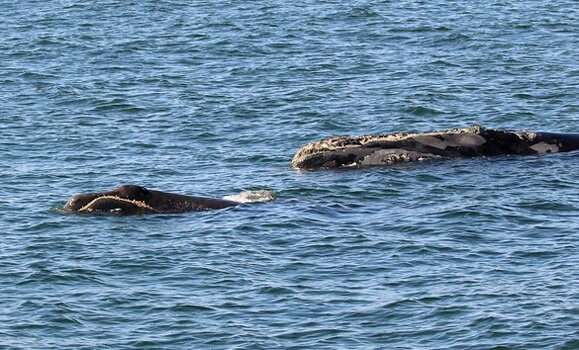North Atlantic right whale and her 2-week-old calf swim south off the coast of Florida earlier this year. Credit: Georgia DNR photo under NOAA Research Permit 20556-01
There is a growing urgency to identify where endangered North Atlantic right whales are migrating, say researchers after a sixth dead mammal was discovered in the Gulf of St. Lawrence.
Boris Worm, a marine biologist at Dalhousie, says it is critical to determine where the massive whales may be traveling if the species is to be saved.
"We have to double down on working on this," he says, adding that the toll is threatening to reach levels seen in 2017 when there were 12 reported right whale deaths in the Gulf.
"This is devastating, you really get this sinking feeling that something's not working. It feels like it's going down the same lines."
A shift in movement
Fisheries and Oceans Canada announced Thursday that a sixth right whale carcass had been spotted drifting off the Gaspe peninsula during an aerial surveillance flight. The department said Friday that Comet, a right whale found floating lifeless near the Acadian peninsula earlier this week, had been towed to P.E.I. to undergo a necropsy to determine the cause of death.
Dr. Worm says the whales appear to be shifting their movements, which may make speed restrictions and other measures put in place to shield them from ship strikes less effective.
He says the whales may be following their food source into different areas of the Gulf and ending up in shipping lanes, where they could be at greater risk of getting hit by large container vessels.
"It could be that the whales are in different places or are choosing different routes into the Gulf and that made these measures somewhat ineffective. So, we have to go back and find out where the whales are, predict their distribution and take measures to protect them."
Eyes from above
One way of tracking the whales may come from the sky.
Olivia Pisano, a Ph.D. student in the Department of Biology, is trying to develop technology to identify the locations of North Atlantic right whales using commercial satellite imagery. That could help speed up the response time for speed reductions or closures if a right whale is spotted in a particular area. Pisano is collaborating on the technology with fellow researchers at Cambridge University in the UK.
"It's really critical to have a new system in place that is near real time," she said. "The problem with these whales is that they change their distribution, so we have no predictability of where they're going to be."
Scientists believe the greatest threats to the slow-moving whales are ship strikes and entanglements in fishing gear. There are only about 400 of the animals left, with only about 100 breeding females in that population.
Dalhousie veterinarian Chris Harvey-Clark said the species is facing multiple challenges, including food depletion, vessel traffic, fishing line entanglements, low calving rates and chronic stress.
"Their history is written on their skin," he said of the scarring that occurs after they are struck by a ship or snarled in rope. "They are scarred up from end to the other…
"If we don't do something, at the current loss rate we will lose the North Atlantic right whale population."
Provided by Dalhousie University























